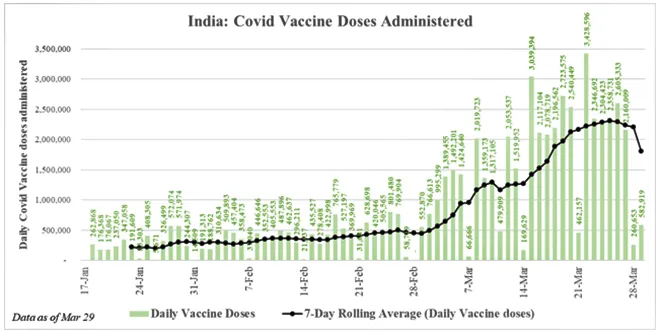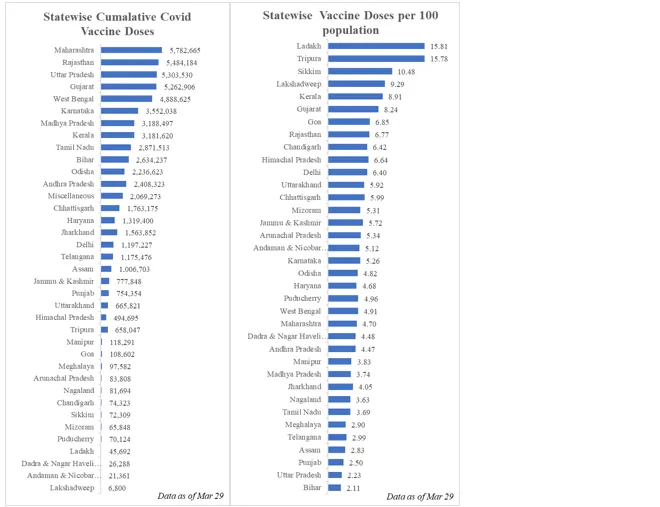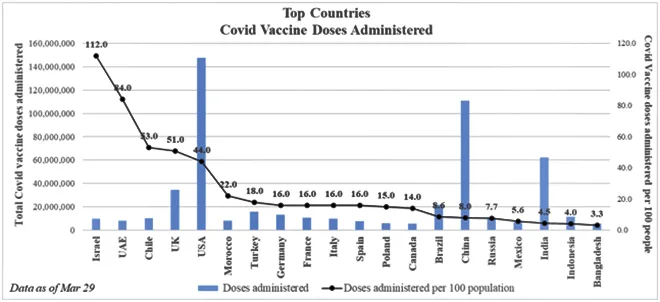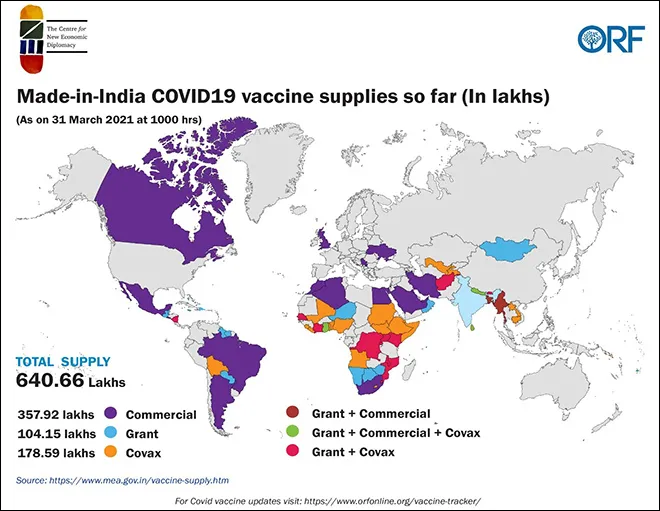
(This is part of the weekly series assessing the COVID-19 vaccine rollout in India and the world)
The second wave of the COVID-19 pandemic has seemingly hit India, where the first week of March had an average of 16,740 cases and as of this week, the average of new cases rose by threefold. The past seven days have seen a sudden surge of more than 50,000 new cases each day.
Amidst the ongoing rise in cases, the COVID vaccination drive continues to expand. India has administered more than 63 million COVID-19 vaccine doses. Relative to the population, the country has administered 4.5 doses per 100 people.
India’s weekly average vaccination rate has surpassed 2.2 million. At the current rate, it will take India 3.1 years to cover 75 percent of its population. This rate saw a worsening for the first time, increasing from 2.4 years to 3.1 years, during the past week. This was possibly due to the meagre rise in the average vaccination rate, attributable to the weekend celebrations of the popular Hindu festival ‘Holi’.
Figure 1: COVID vaccine and case rends in India

 Data source: COVID19India
Data source: COVID19India
Last week, India conducted 15.4 million inoculations, with one of the highest one-day rate of 3.4 million doses. While the initial response to the vaccination was lukewarm, the country has more than doubled its weekly average rate of vaccination in the past three weeks.
Within India, Maharashtra continues to lead in COVID-19 inoculations, with 5.78 million shots. The state currently accounts for more than 50 percent of the new COVID cases in India. The alarming rise of cases in the past two weeks has prompted curfews, lockdowns, and rise in inoculations within the state.
In terms of total vaccine doses, Maharashtra is closely followed by Rajasthan (5.4 million) and Uttar Pradesh (5.3 million). Delhi, even with a high caseload, continues to lag behind with only 1.1 million inoculations in the past two months. Similarly, Punjab that has been observing a surge in new cases in the past few weeks with multiple cases of newer virulent virus variation, remains stagnant in terms of COVID vaccination, with only 0.7 million shots as on date.
Figure 2: Covid Vaccine Trends in Indian States
 Data source: Observer Research Foundation Vaccine Tracker
Data source: Observer Research Foundation Vaccine Tracker
Post initiation of the second phase of its vaccination drive to include people over 60 years of age and those of 45 years and above with comorbid conditions, the average daily vaccination in India has quadrupled. As per Ministry of Health and Family Welfare, 29 million people over the age of 60 and 7 million people between 45-60 years with comorbidities have been vaccinated as of now. This week also witnessed the start of second dose for this category. Beginning April, the country will be starting inoculations for all those above 45 years of age.
Roughly 9 million of India’s population has been completely vaccinated, till date. To attain the target of vaccinating a quarter of its population by August, the vaccination programme needs a push. As the country gears up for opening the vaccination drive to all those above 45 years of age, the country is attempting to expand vaccination centres so that citizens need not travel beyond two kilometers to get vaccinated. Though the vaccination drive has been gradually increasing, amid the spread of new COVID variants and rising cases—vaccinating the priority population is increasingly important.
Global context
Globally, more than 574 million doses have been administered across 141 countries. Last week, 103 million COVID-19 inoculations were conducted in the world. The average daily rate of inoculations has risen from 12.2million doses last week to 14.8 million doses per day this week. This has reduced the time needed to cover 75 percent of the global population from two and a half years to two years in one week.
Figure 3: Country wise COVID vaccine doses administered
 Data source: Bloomberg Vaccine tracker, as on March 26, 1100 hrs
Data source: Bloomberg Vaccine tracker, as on March 26, 1100 hrs
The COVID vaccine drive continues to be dominated by the United States in absolute numbers, with over 147 million doses administered, as of March 29, followed by China (110 million), and India (63 million). In terms of daily rate of doses administered, China has taken the lead with 4.3 million average daily doses, followed by USA (2.7 million doses) and India (1.7 million doses). Relative to population, Israel leads with 112 doses per 100 people, while China and India lag behind with 8 and 4.5 doses per 100 population, respectively.
#VaccineMaitri
The COVID-19 vaccination drive has been a crucial turning point in fighting the ongoing pandemic crisis. Countries that have vaccinated more than 30 percent of their populations are noticing a decline in COVID rates; however, inequalities in vaccine distribution and availability continue to persist.
Out of the total COVID vaccines administered globally, US, EU, and UK account for 44 percent of the doses. Many countries, especially in Africa, are yet to initiate the COVID-19 vaccine drives. While North American and European countries continue to expand their vaccination base, reaching 27 and 16 doses per 100 people, respectively; African countries lag behind. The rate of doses administered in Africa has remained stagnant at 0.7 doses per 100 population in the past week.
Figure 4: COVID vaccine inequitable access
 Data source:PandemIC Vaccination Inequity Tracker
Data source:PandemIC Vaccination Inequity Tracker
There are 67 countries that are yet to initiative COVID vaccination drives, out of which 58 belong to the developing world. Moreover, while 57 percent of the lower-middle-income and lower-income countries have started inoculations, their vaccine coverage lags behind at 3.8 percent, as opposed to the 24 percent population coverage of high-income countries.
India continues to provide vaccines to its partner countries. As of March 31st, the country has supplied over 64 million doses, out of which 10 million were grants. India’s efforts have been key to many developing countries being able to initiate COVID vaccine drives.
Figure 5: India’s global supply of vaccines
 Data source:Ministry of External Affairs, Government of India
Data source:Ministry of External Affairs, Government of India
Even with rumors circulating that the country will be imposing a ban on vaccine exports, last week itself, India was able to supply almost half a million doses to six countries. The Government of India has clarified that it will continue to supply vaccines to its partner countries in a phased manner; however, the timelines may need to be adjusted, given the countries manufacturing potential and the ongoing national vaccination programmes.
Despite sharing doses to 83 countries, India has maintained a consistent rise in inoculations internally. The country is positive that even with the rising exports, it will be able to support the third phase of vaccination. India currently has seven new vaccine candidates in the different phases of clinical trial, with an additional two dozen in pre-clinical trial phase. With this momentum and a push to raise the average daily inoculations to 5 million, India should be able to stay in its course of vaccinating the priority and vulnerable population by August 2021.
The views expressed above belong to the author(s). ORF research and analyses now available on Telegram! Click here to access our curated content — blogs, longforms and interviews.





 Data source:
Data source:  Data source:
Data source:  Data source:
Data source:  Data source:
Data source: Data source:
Data source: PREV
PREV


